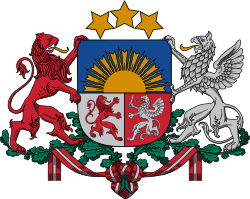Saeima
The Saeima (Latvian pronunciation: [ˈsai.ma]) is the parliament of the Republic of Latvia. It is a unicameral parliament consisting of 100 members who are elected by proportional representation, with seats allocated to political parties which gain at least 5% of the popular vote. Elections are scheduled to be held once every four years, normally on the first Saturday of October. The most recent elections were held in October 2018.
Saeima | |
|---|---|
 | |
| Type | |
| Type | |
| History | |
| Founded | 7 November 1922 |
| Disbanded | temporarily dissolved 1934-1940 suspended from 1940-1991 |
| Leadership | |
Speaker | |
| Structure | |
| Seats | 100 |
 | |
Political groups | Government (58)
Supported by (4)
Opposition (38) |
Length of term | 4 years |
| Elections | |
| Open list proportional representation with a 5% election threshold | |
Last election | 6 October 2018 |
Next election | TBA 2022 |
| Meeting place | |
 | |
| House of the Livonian Noble Corporation, Riga | |
| Website | |
| www | |

 |
|---|
| This article is part of a series on the politics and government of Latvia |
| Foreign relations |
The President of Latvia can dismiss the Saeima and request early elections. The procedure for dismissing it involves substantial political risk to the president, including a risk of loss of office. On 28 May 2011 president Valdis Zatlers decided to initiate the dissolution of the Saeima, which was approved in a referendum, and the Saeima was dissolved on 23 July 2011.[1]
The current Speaker of the Saeima is Ināra Mūrniece.
Deputies are elected to represent one of five constituencies: Kurzeme (13 deputies), Latgale (15), Riga (30), Vidzeme (27), and Zemgale (15). Seats are distributed in each constituency by open list proportional representation among the parties that overcome a 5% national election threshold using an unmodified version of the Webster/Sainte-Laguë method.
History and etymology
The Saeima traces its origins to the Sejm of the Kingdom of Poland, which led to the creation of the Sejm (Seimas) of the Grand Duchy of Lithuania and later to the creation of the Sejm of the Polish-Lithuanian Commonwealth. Latvia, a part of the Polish-Lithuanian Commonwealth, was exposed to the Polish mode of administration and introduced to the Sejm-system. Most of Latvia, incorporated into 3 voivodeships: the Dorpat Voivodeship, the Parnawa Voivodeship and the Wenden Voivodeship, in total sent 6 senators to the Sejm of the Poland. However, the rest of Latvia belonged to the Duchy of Courland and Semigallia, which as a direct fief of the Commonwealth (therefore not a member of the Union with equal rights) was governed by the Sejm, but could not send its own senators to it. Local councils called sejmik (little Sejm) stretched across all of Latvia.
The word sejm derives from the verb "sjąć się" meaning "to get together", with similar words in some other Slavic languages,[2] of proto-Slavic origin *sъjęti < *sъjemti[3] Sejm, then, as a noun meant "a gathering, a meeting, a council.”
In the 19th century, as the concept of nations began to emerge, Juris Alunāns, a member of a Latvian nationalist group called the Young Latvians, claimed ownership to the word "Saeima". Despite exactly the same sound, same semantic structure and clear historical connotations, he claimed that it was a purely Latvian word that he had invented. As mentioned earlier, the word bears the same meaning: "a gathering, a meeting, a council". Juris Alunāns claimed that he “constructed“ it completely independently of the historical context spanning centuries and independently of the contemporarily functioning sejms in the Duchy of Warsaw, Congress Poland, Grand Duchy of Poznan and Galicia. He claimed that the word he constructed stemmed from the archaic Latvian word eima instead, meaning "to go" (derived from the PIE *ei "to go" and also a cognate with the Ancient Greek eimi, Gaulish eimu, among others).[4]
He could not explain, however, how the s- prefix got added to the word, and what sense this addition made within the limits of the Latvian language. Nevertheless, according to Juris, the word is purely Latvian and completely independent of the aforementioned historical context.
In the pre-war Latvia, the Saeima was elected for three-year terms. The 1st Saeima met from 7 November 1922 to 2 November 1925, the 2nd from 3 November 1925 to 5 November 1928, the 3rd from 6 November 1928 to 2 November 1931, and the 4th from 3 November 1931 to 15 May 1934 (date of the Latvian coup d'état).
Most recent election
Summary of the 6 October 2018 Latvian Saeima election results
| Party | Votes | % | Seats | +/– | ||
|---|---|---|---|---|---|---|
| Harmony | 167,117 | 19.80 | 23 | –1 | ||
| Who Owns the State? | 120,264 | 14.25 | 16 | New | ||
| New Conservative Party | 114,694 | 13.59 | 16 | +16 | ||
| Development/For! | 101,685 | 12.04 | 13 | +13 | ||
| National Alliance | 92,963 | 11.01 | 13 | –4 | ||
| Union of Greens and Farmers | 83,675 | 9.91 | 11 | –10 | ||
| New Unity | 56,542 | 6.69 | 8 | –15 | ||
| Latvian Association of Regions | 35,018 | 4.14 | 0 | –8 | ||
| Latvian Russian Union | 27,014 | 3.20 | 0 | 0 | ||
| The Progressives | 22,078 | 2.61 | 0 | New | ||
| For Latvia from the Heart | 7,114 | 0.84 | 0 | –7 | ||
| Latvian Nationalists | 4,245 | 0.50 | 0 | New | ||
| For an Alternative | 2,900 | 0.34 | 0 | New | ||
| SKG Union (LSDSP–KDS–GKL) | 1,735 | 0.20 | 0 | New | ||
| Eurosceptic Action Party | 1,059 | 0.12 | 0 | New | ||
| Latvian Centrist Party | 897 | 0.10 | 0 | New | ||
| Invalid/blank votes | 5,925 | – | – | – | ||
| Total | 844,925 | 100 | 100 | 0 | ||
| Registered voters/turnout | 1,548,100 | 54.58 | – | – | ||
| Source: CVK | ||||||
See also
- Category:Deputies of the Saeima
- Deputies of the Saeima
- List of Deputy Speakers of the Saeima
- People's Council of Latvia - provisional parliament from 1918-1920
- Constitutional Assembly of Latvia - consented to the Satversme in 1922
References
- "Zatlers nolemj rosināt Saeimas atlaišanu" [Zatlers decides to initiate thedissolution of the Saeima]. Delfi (in Latvian). May 28, 2011. Retrieved May 28, 2011.
- Aleksander Brückner, Słownik etymologiczny języka polskiego, 2005 Krakowska spółka wydawnicza, s. 502
- Zuicena, Ieva; Migla, Ilga (2008). "Jura Alunāna devums latviešu leksikogrāfijā" (PDF). LU Raksti (in Latvian). 731: 75. ISSN 1407-2157. Retrieved 2010-05-27.
.jpg)
.svg.png)